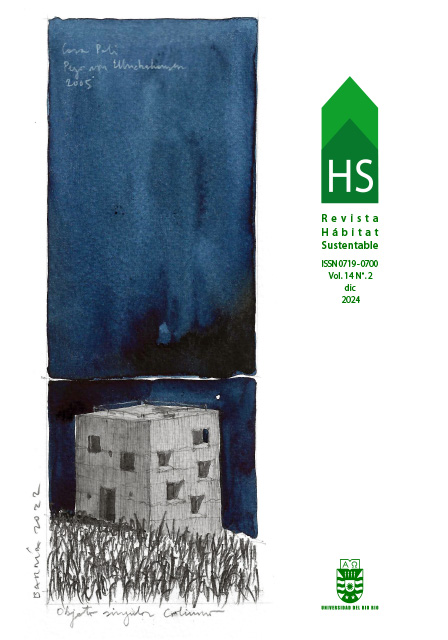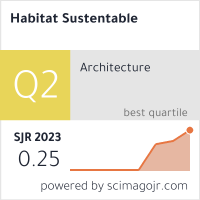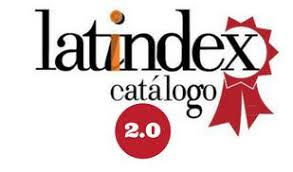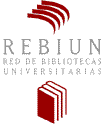Potential of a low-cost system for measuring indoor environmental quality in Latin american extreme climates towards energy equity
DOI:
https://doi.org/10.22320/07190700.2024.14.02.06Keywords:
environmental measurement system, low-cost sensors, indoor environmental quality, pollutant measurementAbstract
Public health has multidisciplinary challenges involving a combination of physical, mental, and social welfare. Two limitations to quantifying indoor pollutants (gases, chemical compounds, and suspended particles) are the high cost and the complexity of available measurement systems. Under this scenario, an experimental approach was used to develop a low-cost system to measure variables that affect human and environmental health. Calibration, validation, and technical adjustment processes were conducted in an extreme-climate location in southern Mexico, following domestic and international standards. The key results showed the feasibility of using low-cost tools to measure pollutants in developing countries. 57% of the data for H2S had a result above 150 ppm, which is considered harmful to human health. On the other hand, developing the measurement system in the studied locality showed the importance of having data to measure environmental pollution levels according to each region's habits and customs. Sensors and open access systems were used as these can directly benefit resource-constrained researchers and the public and private sectors interested in measuring environmental and comfort variables to promote universal access to knowledge.
Downloads
References
AFROZ, R., GUO, X., CHENG, C.-W., DELORME, A., DURUISSEAU-KUNTZ, R., & ZHAO, R. (2023). Investigation of indoor air quality in university residences using low-cost sensors. Environmental Science: Atmospheres, 3(2), 347–362. https://doi.org/10.1039/d2ea00149g
ASHRAE. (2024, March 6). Indoor Air Quality Guide. ASHRAE. https://www.ashrae.org/technical-resources/bookstore/indoor-air-quality-guide
BALZA, L., CASTRO VARGAS, S., GÓMEZ PARRA, N., JIMENEZ MORI, R. A., MANZANO, O., & SEREBRISKY, T. (2024). Does Income Growth in Latin America and the Caribbean Drive Disproportionate Energy Consumption? IDB. https://doi.org/10.18235/0012883
BURBANK, A. J., HERNANDEZ, M. L., JEFFERSON, A., PERRY, T. T., PHIPATANAKUL, W., POOLE, J., & MATSUI, E. C. (2023). Environmental justice and allergic disease: A Work Group Report of the AAAAI Environmental Exposure and Respiratory Health Committee and the Diversity, Equity and Inclusion Committee. Journal of Allergy and Clinical Immunology, 151(3), 656–670. https://doi.org/10.1016/j.jaci.2022.11.025
COWELL, N., CHAPMAN, L., BLOSS, W., SRIVASTAVA, D., BARTINGTON, S., & SINGH, A. (2022). Particulate matter in a lockdown home: evaluation, calibration, results and health risk from an IoT enabled low-cost sensor network for residential air quality monitoring. Environmental Science: Atmospheres, 3(1), 65–84. https://doi.org/10.1039/d2ea00124a
DABANLIS, G., LOUPA, G., TSALIDIS, G. A., KOSTENIDOU, E., & RapSOMANIKIS, S. (2023). The Interplay between Air Quality and Energy Efficiency in Museums, a Review. Applied Sciences, 13(9), 5535. https://doi.org/10.3390/app13095535
Environmental Protection Agency. (2022). Criteria Air Pollutants. NAAQS Table. https://www.epa.gov/criteria-air-pollutants/naaqs-table
ENYOH, C. E., VERLA, A. W., QINGYUE, W., OHIAGU, F. O., CHOWDHURY, A. H., ENYOH, E. C., CHOWDHURY, T., VERLA, E. N., & CHINWENDU, U. P. (2020). An overview of emerging pollutants in air: Method of analysis and potential public health concern from human environmental exposure. Trends in Environmental Analytical Chemistry, 28, e00107. https://doi.org/10.1016/j.teac.2020.e00107
FREDERICKSON, L. B., RUSSELL, H. S., FESSA, D., KHAN, J., SCHMIDT, J. A., JOHNSON, M. S., & HERTEL, O. (2023). Hyperlocal air pollution in an urban environment - measured with low-cost sensors. Urban Climate, 52. 101684. https://doi.org/10.1016/j.uclim.2023.101684
GARCIA, M. RAMÍREZ, H., ULLOA, H., GARCÍA, O., MEULENERT, A., & ALCALÁ, J. (2013). Concentración de contaminantes SO2 , NO2 y correlación con H, SO4 y NO3 durante la temporada de lluvias en la Zona Metropolitana de Guadalajara , Jalisco , México. Revista Chilena de Enfermedades Respiratorias., 29(2), 81–88.
GANGWAR, M., JAMAL, Y., USMANI, M., WU, C.-Y., & JUTLA, A. S. (2024). Carbon dioxide as an indicator of bioaerosol activity and human health in K-12 school systems: a scoping review of current knowledge. Environmental Research: Health, 2(1), 012001. https://doi.org/10.1088/2752-5309/ad1c41
GINEBREDA, A., & BARCELÓ, D. (2022). Data-based interpretation of emerging contaminants occurrence in rivers using a simple advection-reaction model. Water Emerging Contaminants & Nanoplastics, 1(3), 12. https://doi.org/10.20517/wecn.2022.07
JUNG, C. R., NISHIHAMA, Y., NAKAYAMA, S. F., TAMURA, K., ISOBE, T., MICHIKAWA, T., IWAI-SHIMADA, M., KOBAYASHI, Y., SEKIYAMA, M., TANIGUCHI, Y., & YAMAZAKI, S. (2021). Indoor air quality of 5,000 households and its determinants. Part B: Volatile organic compounds and inorganic gaseous pollutants in the Japan Environment and Children’s study. Environmental Research, 197. 111135. https://doi.org/10.1016/j.envres.2021.111135
KALIA, P., & ANSARI, M. A. (2020). IOT based air quality and particulate matter concentration monitoring system. Materials Today: Proceedings, 32(3), 468–475. https://doi.org/10.1016/j.matpr.2020.02.179
KHALIL, N. A., & KAMOONA, G. M. I. (2022). The Effect of Indoor Air Quality in University Classrooms on the Immunity of Its Occupants. International Journal of Sustainable Development and Planning, 17(8), 2453–2461. https://doi.org/10.18280/ijsdp.170813
KIM, S., & SOHANCHYK, G. (2022). Exploring Children’s Engagement in Monitoring Indoor Air Quality: Longitudinal Study. JMIR Formative Research, 6(1), e32404. https://doi.org/10.2196/32404
KOENGKAN, M., POVEDA, Y. E., & FUINHAS, J. A. (2020). Globalisation as a motor of renewable energy development in Latin America countries. GeoJournal, 85(6), 1591–1602. https://doi.org/10.1007/s10708-019-10042-0
MENTESE, S., MIRICI, N. A., ELBIR, T., PALAZ, E., MUMCUOĞLU, D. T., COTUKER, O., BAKAR, C., OYMAK, S., & OTKUN, M. T. (2020). A long-term multi-parametric monitoring study: Indoor air quality (IAQ) and the sources of the pollutants, prevalence of sick building syndrome (SBS) symptoms, and respiratory health indicators. Atmospheric Pollution Research, 11(12), 2270–2281. https://doi.org/10.1016/j.apr.2020.07.016
Ministry of Environment and Natural Resources. (2024, April 4). National Air Quality Information System. Monitoring Network SDS01. https://sinaica.inecc.gob.mx/
National Institute of Public Health. (2022). Environment and Health. https://www.insp.mx/
NICHOLAS J. V., & WHITE D. R. (2001). Calibration. In Traceable Temperatures (pp. 159–201). John Wiley & Sons, Ltd. https://doi.org/https://doi.org/10.1002/0470846151.ch5
NILANDITA, W., MUNFARIDA, I., RATODI, M., RATRI NURMANINGSIH, D., & SUPRAYOGI, D. (2019). The Indoor Air Quality in Laboratory Buildings. A Case Study in Integrated Laboratory of UIN Sunan Ampel Surabaya. KnE Social Sciences. 3(21), 873-882. https://doi.org/10.18502/kss.v3i21.5018
NUGROHO, A. P., OKAYASU, T., HORIMOTO, M., ARITA, D., HOSHI, T., KUROSAKI, H., YASUBA, K., INOUE, E., HIRAI, Y., MITSUOKA, M., & SUTIARSO, L. (2016). Development of a Field Environmental Monitoring Node with Over the Air Update Function. Agricultural Information Research, 25(3), 86–95. https://doi.org/10.3173/air.25.86
NURHISANAH, S., & HASYIM, H. (2022). Environmental health risk assessment of sulfur dioxide (SO2) at workers around in combined cycle power plant (CCPP). Heliyon, 8(5), e09388. https://doi.org/10.1016/j.heliyon.2022.e09388
Occupational Safety and Health Administration (OSHA). (2024, March 6). Hydrogen Sulfide. OSHA. https://www.osha.gov/hydrogen-sulfide
Occupational Safety and Health Administration (OSHA). (2015). Indoor air quality in commercial and institutional buildings. 1–32. https://www.osha.gov/sites/default/files/publications/3430indoor-air-quality-sm.pdf
ORTIZ SALVADOR, E. G., RICOY ZÁRATE, E. G., CARRETO HERNÁNDEZ, L. G., SOTELO RODRIGUEZ, P., MOYA ACOSTA, S. L., & CAMPOS AMEZCUA, R. (2022). Numerical and Experimental Study of Cross Ventilation in a Room of a House in the State of Morelos, EasyChair Preprint, 9209. https://easychair.org/publications/preprint/slwnP
QUAH, S. (Ed). (2021). American Society of Heating, Refrigerating and Air-Conditioning Engineers. International Encyclopedia of Public Health (Second Edition, Vol. 2, Issue 1, pp. 56-57). https://doi.org/10.1016/0140-7007(79)90114-2
Red Universitaria de Observatorios Atmosféricos. (2023). Observatorio Atmosférico Mérida. https://www.ruoa.unam.mx/index.php?page=estaciones&id=8
Secretaría de Medio Ambiente y Recursos Naturales. (2024, March 7). NOM-081-SEMARNAT-1994. Límites Máximos Permisibles de Emisión de Ruido de Las Fuentes Fijas y Su Método de Medición. https://biblioteca.semarnat.gob.mx/janium/Documentos/Ciga/agenda/PPD02/081.pdf
Secretaría de Salud. (2019). NOM-022-SSA1-2019 Salud ambiental. Criterio para evaluar la calidad del aire ambiente, con respecto al dióxido de azufre. https://www.dof.gob.mx/nota_detalle.php?codigo=5568395&fecha=20/08/2019#gsc.tab=0
Secretaría de Salud. (2021a). NOM-020-SSA1-2021 Criterio para evaluar la calidad del aire ambiente, con respecto al ozono. https://dof.gob.mx/nota_detalle.php?codigo=5633956&fecha=28/10/2021#gsc.tab=0
Secretaría de Salud. (2021b). NOM-021-SSA1-2021 Criterio para evaluar la calidad del aire ambiente, con respecto al monóxido de carbono. https://www.dof.gob.mx/nota_detalle.php?codigo=5634084&fecha=29/10/2021#gsc.tab=0
Secretaría de Salud. (2021c). NOM-026-SSA1-2021 Criterio para evaluar la calidad del aire ambiente, con respecto al plomo. https://www.dof.gob.mx/nota_detalle.php?codigo=5634085&fecha=29/10/2021#gsc.tab=0
Secretaría de Salud. (2022a). NOM-023-SSA1-2021 Criterio para evaluar la calidad del aire ambiente, con respecto al dióxido de nitrógeno. https://dof.gob.mx/nota_detalle.php?codigo=5633854&fecha=27/10/2021#gsc.tab=0
Secretaría de Salud. (2022b). NOM-025-SSA1-2014 Valores límite permisibles para la concentración de partículas suspendidas. https://www.dof.gob.mx/nota_detalle.php?codigo=5357042&fecha=20/08/2014#gsc.tab=0
Sistema Meteorológico Nacional. (2020). Climatic conditions. https://smn.conagua.gob.mx/es/climatologia/informacion-climatologica/normales-climatologicas-por-estado
TANG, R., & PFRANG, C. (2023). Indoor particulate matter (PM) from cooking in UK students’ studio flats and associated intervention strategies: evaluation of cooking methods, PM concentrations and personal exposures using low-cost sensors. Environmental Science: Atmospheres, 3(3), 537–551. https://doi.org/10.1039/d2ea00171c
TRAN, V. VAN, PARK, D., & LEE, Y.-C. (2020). Indoor Air Pollution, Related Human Diseases, and Recent Trends in the Control and Improvement of Indoor Air Quality. International Journal of Environmental Research and Public Health, 17(8), 2927. https://doi.org/10.3390/ijerph17082927
World Health Organization. (2021). Global Air Quality Guidelines 2021. 1–16. https://iris.who.int/bitstream/handle/10665/345329/9789240034228-eng.pdf?sequence=1
Downloads
Published
How to Cite
Issue
Section
License
Copyright (c) 2024 Claudia Eréndira Vázquez-Torres, Renán Gabriel Quijano-Cetina, Israel Sánchez-Domínguez, Bassam Ali

This work is licensed under a Creative Commons Attribution-ShareAlike 4.0 International License.
The content of articles which are published in each edition of Habitat Sustentable, is the exclusive responsibility of the author(s) and does not necessarily represent the thinking or compromise the opinion of University of the Bio-Bio.
The author(s) conserve their copyright and guarantee to the journal, the right of first publication of their work. This will simultaneously be subject to the Creative Commons Recognition License CC BY-SA, which allows others to share-copy, transform or create new materials from this work for non-commercial purposes, as long as they recognize authorship and the first publication in this journal, and its new creations are under a license with the same terms.











 Scientific Information Program/Concurso Fondos de Publicación de Revistas Científicas 2018/ Proyecto Mejoramiento de Visibilidad de Revistas UBB (Código:FP180007).
Scientific Information Program/Concurso Fondos de Publicación de Revistas Científicas 2018/ Proyecto Mejoramiento de Visibilidad de Revistas UBB (Código:FP180007).





